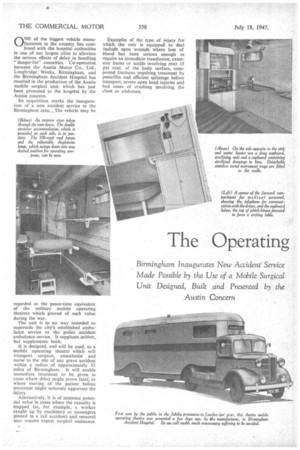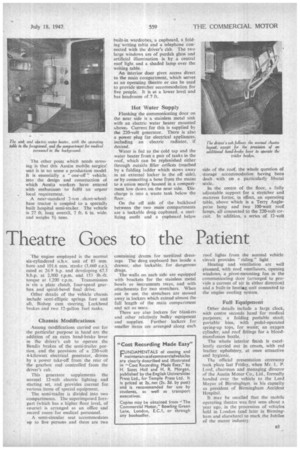The Operating Theatre Goes to the Patient
Page 36

Page 37

If you've noticed an error in this article please click here to report it so we can fix it.
Birmingham Inaugurates New Accident Service Made Possible by the Use of a Mobile Surgical Unit Designed, Built and Presented by the Austin Concern
ONE of the biggest vehicle manufacturers in the country has combined with the hospital authorities in one of our largest cities to alleviate the serious effects of delay in handling "danger-list" casualties. Co-operation between the Austin Motor Co„ Ltd., Longbridge Works, Birmingham, and the Birmingham Accident Hospital has resulted in the production of the Austin mobile surgical unit, which has just been presented to the hospital by the Austin concern.
Its acquisition marks the inauguration of a new accident service in the Birmingham area. • The vehicle may be regarded as the peace-time equivalent of the military mobile operating theatres which proved of such value during the war.
The unit is in no way intended to supersede the city's established ambulance service or the police accident ambulance service, it supplants neither, but supplements both.
It is designed, and will be used, as a mobile operating theatre which will transport surgeon, anmsthetist and nurse to the site of any grave accident within a radius of approximately 12 miles of Birmingham. It will enable immediate treatment to he given in cases where delay might prove fatal, or where moving of the patient before treatment might seriously aggravate the injury.
Alternatively, it is of immense potential value in cases where the casualty is trapped (as, for example, a worker caught up by machinery or passengers pinned in a rail accident) and removal may require expert surgical assistance. Examples of the type of injury for which the unit is equipped to deal include open wounds where loss of blood has been serious enough to require an immediate transfusion, extensive burns or scalds involving over 15 per cent, of the body surface, compound fractures requiring treatment by penicillin and efficient splintage before transport, severe open head injuries and had cases of crushing involving the chest or abdomen.
The other point which needs stressing is that this Austin mobile surgical unit is in no sense a production model. It is essentially a " one-off " vehicle, into the design and construction of which Austin workers have entered with enthusiasm to fulfil an urgent , local requirement.
A near-standard 2-ton . short-wheelbase tractor is coupled to a specia14 built hospital semi-trailer. The vehicle is 27 ft. long overall, 7 ft. 6 in. wide, and weighs 54 tons.
The engine employed is the normal six-cylindered o.h.v. unit of 85 mm. bore and 101.6 mm. stroke (3,460 c.c.), rated at 26.9 h.p. and developing 67.5 b.h.p. at 2,900 r.p.m. and 153 lb.-ft.
torque at 1,200 r.p.m. Transmission is via a plate clutch, four-speed gearbox and spiral-bevel final drive.
Other details of the vehicle chassis include semi-elliptic springs fore and aft, Bishop cam steering, Lockheed brakes and two 12-gallon fuel tanks.
Chassis Modifications
Among modifications carried out for the particular purpose in hand are the addition of an extra hand-brake lever in the driver's cab to operate the Bendix brakes of the semi-trailer portion, and the provision of a 220-volt 4-kilowatt electrical generator, driven by a power take-off from the rear of the gearbox and controlled from the driver's cab.
This generator supplements the normal 12-volt electric lighting and starting set, and provides current for, various items of special equipment.
The semi-trailer is divided into two compartments. The superimposed forepart (which has a higher floor level, of course) is arranged as an office and record room for medical personnel.
A semi-circular seat accommodates up to five persons and there are two built-in wardrobes, a cupboard, a folding writing table and a telephone connected with the driver's dab. The two large windows are of purdah glass and artificial illumination is by a central roof light and a shaded lamp over the writing table.
An interior door gives access direct to the main compartment, which serves as an operating theatre or can be used to provide stretcher accommodation for five people. It is at a lower level and has headroom of 7 ft.
Hot Water Supply
Flanking the communicating door on the near side is a stainless metal sink with an electric water heater mounted above. Current for this is supplied by the 220-volt generator. There is also a power plug for electrical appliances, including an electric radiator, if desired.
Water is fed to the cold tap and the water heater from a pair of tanks in the roof, which can be replenished either through outside filler orifices (reached by a folding ladder which stows away in an external locker in the off side), or by connecting a hose from the mains to a union neatly housed in a compartment low down on the near side. Discharge is into a waste tank below the floor.
On the off side of the bulkhead between the two main compartments are a lockable drug cupboard, a sterilizing outfit and a cupboard below containing drums for sterilized dressings. The drug cupboard has inside a drawer, also lockable, for dangerous drugs. The walls on each side are equipped with brackets for the stainless metal bowls or instruments trays, and with attachments for two stretchers. When not in use, the stretchers are stowed away in lockers which extend almost the full length of the main compartment and act as seats.
There are also lockers for blankets and other relatively bulky equipment and supplies. Further lockers for smatter items are arranged along each side of the roof, the whole question of storage accommodation having been dealt with on a particularly liberal scale.
In the centre of the floor, a fully adjustable support for a stretcher and mattress forms, in effect, an operating table, above which is a Terry Anglepoise lamp and two I00-watt roof lamps, all connected to the 220-volt circuit. In addition, a series of 12-volt roof lights from the normal vehicle circuit provides "riding' light Heating and ventilation are well -planned, with roof ventilators, opening windows, a pivot-mounting fan in the communicating door (arranged to provide a current of air in either direction) and a built-in heating unit connected to the engine cooling system.
Full Equipment
Other details include a large clock, with centre seconds hand for medical purposes; a folding portable stool; portable bins, with pedal-operated spring-up tops, for waste; an oxygen cylinder, and roof fittings for a bloodtransfusion bottle.
The whole interior finish is excellently carried out in cream, with red leather upholstery, at once attractive and hygienic.
The official presentation ceremony took place last Friday, when Mr. L. P. Lord, chairman and managing director of the Austin Motor Co., Ltd., formally handed over the vehicle to the Lord Mayor of Birmingham, in his capacity as president of Birmingham Accident Hospital.
It may be recalled that the mobile operating theatre was first seen about a year ago, in the procession of vehicles held in London (and later in Birmingham and elsewhere) to mark the Jubilee of the motor industry.




















































































